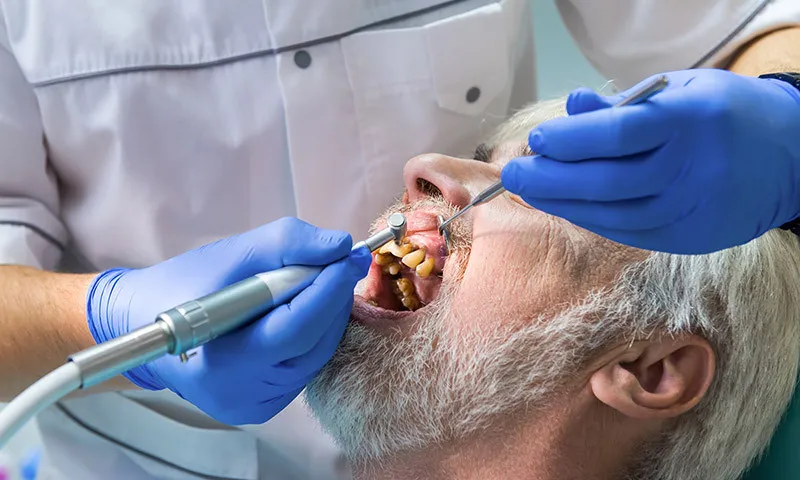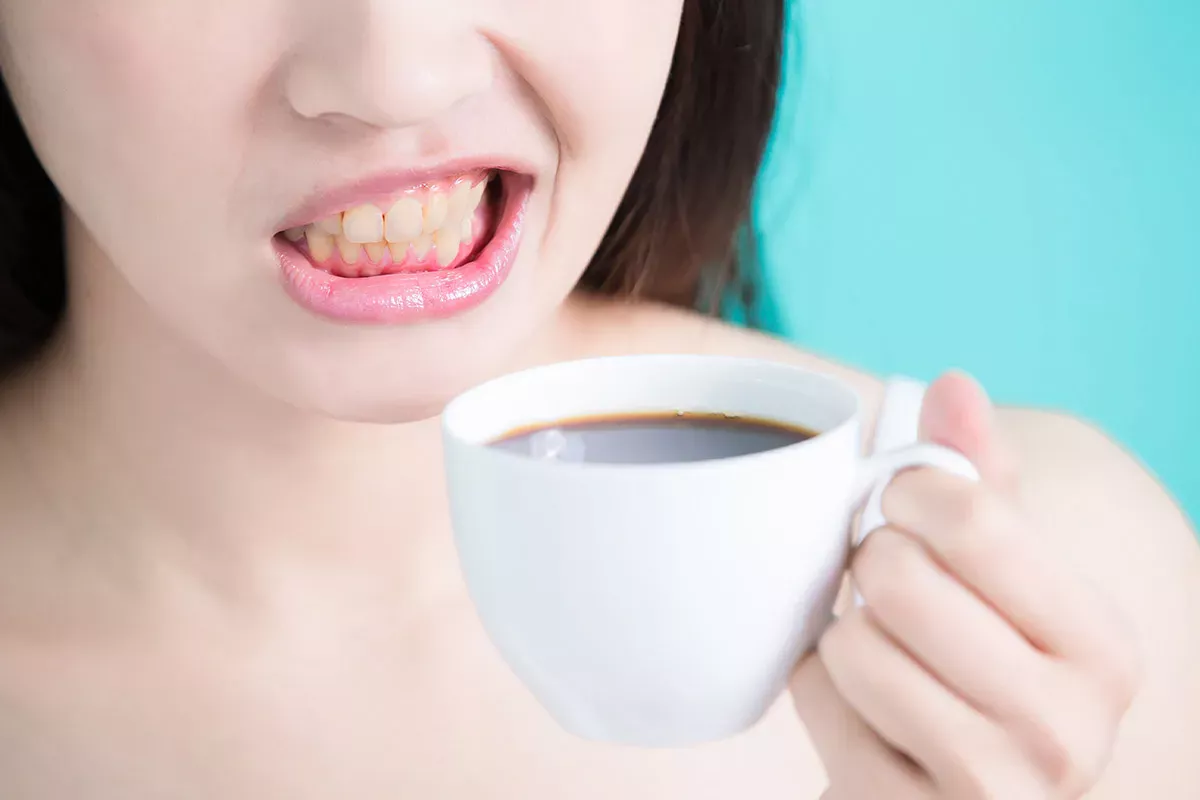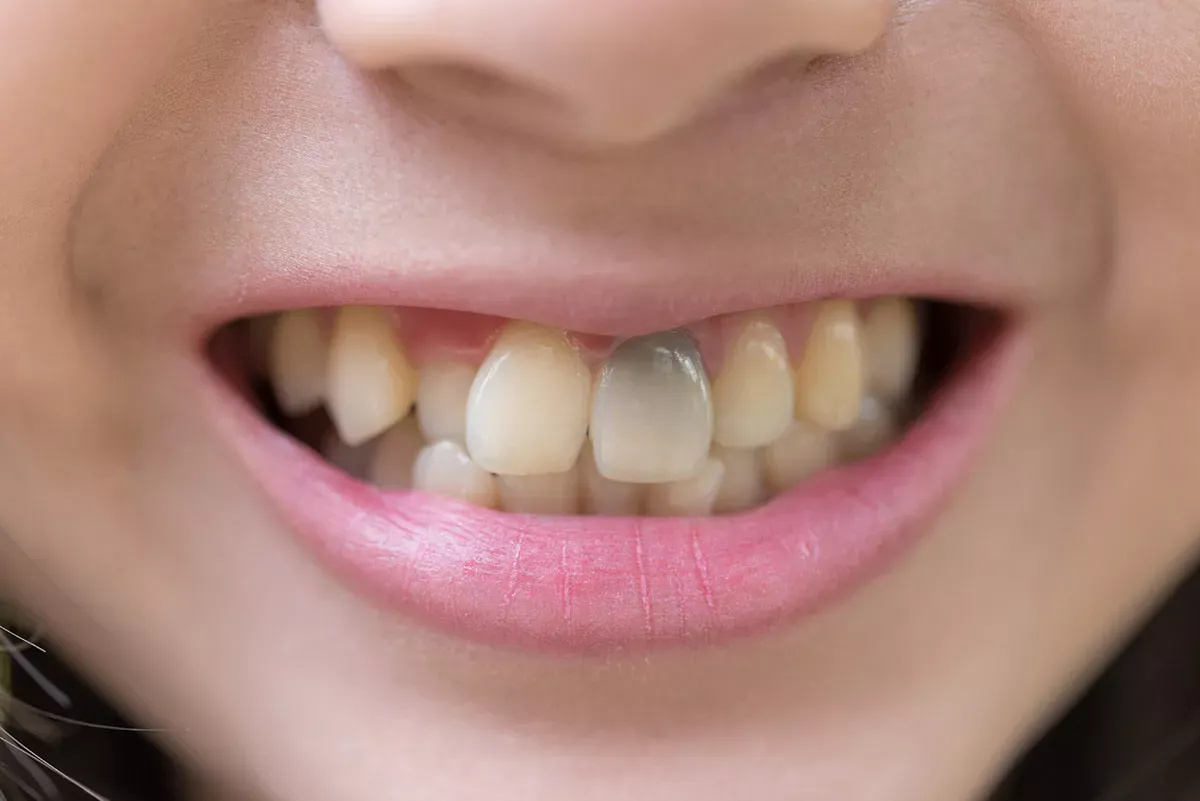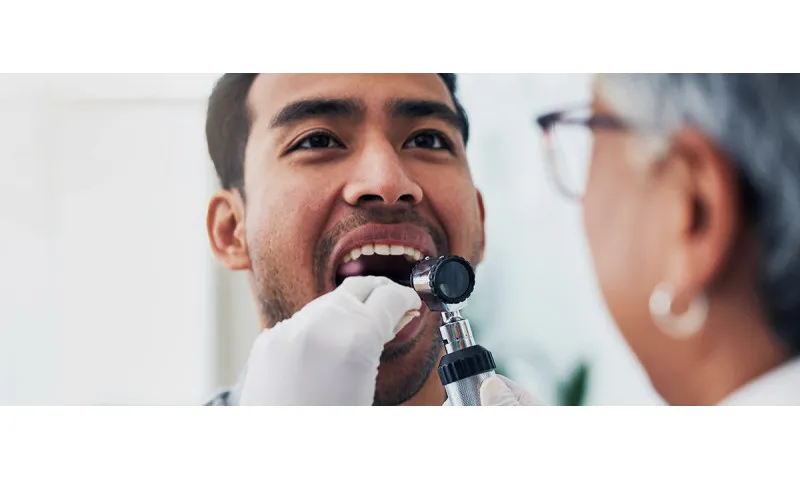Causes of discoloured teeth
Every set of teeth has an individual colour - there is no such thing as a "uniform white". Our genes are responsible for our personal shade of colour. They determine how our tooth enamel and the underlying dentin are composed. This determines whether the teeth appear white, beige or yellowish and how much they discolour over the course of a lifetime. What's more, the colour of our own teeth does not remain the same throughout our lives. They change colour over time. There are various reasons for this, which we will explain to you below.
Good to know:
With the right toothpaste, you can brush your teeth properly and even out or even remove discolouration, for example with Black is White from Curaprox. A combination of enzymes, activated charcoal and a blue filter make unsightly discolouration disappear.
External factors
External (also: extrinsic) tooth discolouration occurs on the tooth surface and - as the name suggests - is caused by external factors such as the consumption of certain foods. The good news is that this type of tooth discolouration can often be remedied quite easily with professional teeth cleaning. Here are some examples of extrinsic factors:
Contact with colourants
The dark pigments in foods and stimulants such as red wine, black or green tea, coffee, cola, spices, fruit or tobacco attach themselves to the teeth - more precisely, in the many small depressions and grooves with which our teeth are covered. In the case of coffee, for example, it is so-called tannins that cause tooth discolouration. These are vegetable tannins with a brown colour.
Neglected oral hygiene
Our teeth are particularly at risk of discolouration if they are covered with a layer of plaque. The colour pigments from luxury foods and foodstuffs just described love the rough surface of this plaque and have a really good time there. They penetrate the biofilm and settle in the tooth enamel. Once this has happened, professional tooth cleaning is the only way to get rid of the discolouration. Therefore: brush your teeth regularly - ideally at least twice a day.
Incorrect oral hygiene
It is not only important to brush your teeth regularly, but also to use the right technique. Anyone who makes mistakes here risks tooth discolouration. They occur, for example, when we exert too much pressure when brushing. This removes the enamel that covers the yellowish colour of the underlying dentin. The less enamel there is, the more visible this yellow colour becomes.
Good to know:
Poor or incorrect oral hygiene increases the risk of yellow teeth. Therefore, make sure you clean your teeth and the entire oral cavity effectively. How does this work? Find out in our detailed guide.
Mouthwash
Many people think they are doing themselves a favour by using a mouthwash after brushing their teeth. However, this is a fallacy. The daily use of mouth rinses can discolour teeth due to some of the ingredients (chlorhexidine). Important to know: The use of such solutions is not necessary for optimal oral hygiene. If you brush your teeth conscientiously and also clean the spaces between your teeth with interdental brushes, you are on the safe side.
Teeth grinding
Teeth grinding can cause major damage to the teeth - often unnoticed. The tooth surfaces wear down in the long term and very fine, so-called microcracks can occur. These ensure that the teeth can become discoloured right down to the inside.
Internal (intrinsic) factors
If discoloured teeth are caused by internal factors, professional tooth cleaning cannot usually do much to restore whiter teeth. This is because the discolouration is on the inside of the affected tooth and not just on the outside. Why such discolouration occurs on the inside can be attributed to various factors, some of which we present to you here.
Natural ageing process
Everyone's teeth discolour over time as they get older. The reason for tooth discolouration in old age is the fact that our tooth enamel wears away over the years. If it is still quite thick when we are young, its white-grey and transparent appearance - as briefly mentioned above - ensures that the underlying yellowish dentin colour is concealed. If the enamel becomes thinner over time, the yellowish colour shines through more intensely.
Certain diseases
Some diseases can be accompanied by tooth discolouration. These include Alzheimer's and coeliac disease.
Too much fluoride during tooth development
Even your child can be affected by tooth discolouration with its milk teeth - for example, if it absorbs excessive amounts of fluoride during its tooth development. This can happen if in toddlers n or even older children use toothpaste that is not suitable for their age and is therefore enriched with too much fluoride. If children are given too much fluoride, this can damage the tooth enamel, which - as we already know - forms the "covering" over the naturally yellowish dentin.
Good to know:
Fluorides support the remineralisation of our teeth and reduce the risk of tooth decay. But in what quantities do we need to take it? And are there any disadvantages? Find out in our article.
Dead tooth
If a tooth is no longer vital (e.g. after root canal treatment or after an accident), it can discolour from the inside out so that the tooth turns grey or black.
Amalgam -fillings
Amalgam fillings consist largely of mercury. With their silvery colour, they are highly visible in the mouth anyway and are therefore not very popular with many patients. In addition, amalgam can also stain the tooth in question grey over time.
Certain medications
Some medications carry the risk of discolouring the teeth - both in adults and children . This applies in particular to certain antibiotics (e.g. tetracycline and amoxicillin ), but also to other medications such as neuroleptics, blood pressure medication, antihistamines and iron tablets.
What does the tooth colour say?
When a tooth discolours, very different shades can appear. Some teeth become yellowish, some suddenly shimmer grey or even black and green. Only your dentist can tell you for sure what these colours mean in your individual case. We are only giving you a brief indication of the possible causes of your tooth colour.
Green teeth
Green teeth can appear in children and indicate an intrinsic cause - this could be jaundice, for example. If the milk teeth are affected by the discolouration, there is usually no need to take action on the pure appearance (but of course on the cause), as the milk teeth are later replaced by the permanent teeth.
Adults can also develop green teeth. In them, they indicate bacteria or a fungal infestation, which often spread in the mouth due to poor oral hygiene. However, taking certain medications can also make teeth appear greenish. Make sure you have a thorough check-up with your doctor.
Black/grey teeth
If a tooth becomes black or grey, this unfortunately indicates that it has died or is in the process of doing so. A dead tooth can be caused by caries bacteria if they have already penetrated the tooth enamel and reached the dental pulp. The tooth is then no longer supplied with nutrients. However, a so-called tooth trauma may also have occurred. This could be a fall on the mouth, for example, which has damaged the tooth so permanently that it dies. Sometimes this only happens many years after the event. Black teeth can affect both children and adults and must be treated. Otherwise, those affected risk chronic inflammation and the loss of the tooth.
Incidentally, in children and adolescents in particular, the black appearance may simply be "just" dark-coloured residues. This is not plaque, but colour deposits caused by the interaction of saliva and bacterial metabolic products. In dentistry, this is referred to as melanodontia disease. It is characterised by the fact that the entire tooth does not turn black, but dots or lines form along the gum line. These deposits are harmless and do not damage the tooth. What many people don't realise: Melanodontia has nothing to do with poor oral hygiene - those affected cannot brush the plaque away themselves. It may be possible to at least slow down the discolouration by using a sonic toothbrush. However, existing stains must be removed by a dentist.
Good to know:
Sonic toothbrushes allow you to brush your teeth effectively, gently and, above all, very easily. You can usually switch between different intensity levels and also choose the brush head to suit your taste. The Black is White Edition from Curaprox also has brush heads with activated charcoal-coated bristles for an additional whitening effect.
Brown teeth
If you suffer from brown teeth, you may be a connoisseur of red wine, black tea, coffee and/or garlic. All of these can colour your teeth brown - as can some juices. Certain antibiotics or simply caries bacteria can also be responsible for the unsightly colour. The good news is that we can work on almost all of these causes ourselves. By avoiding certain stimulants, we can already do a lot for a beautiful white colour of our teeth. If an antibiotic is really to blame for the discolouration, you should talk to your doctor and ask what alternative medication might be an option.
Yellow teeth
There are many possible causes of yellow teeth. The foods already mentioned, such as coffee and red wine, can also play a role here. However, inadequate oral hygiene is also a common cause. If we do not brush our teeth regularly enough, plaque builds up on them. This biofilm takes on a yellowish colour and gives our teeth a rather unsightly appearance. The first way to tackle yellow teeth is to take a critical look at your own oral hygiene and intensify it if necessary. Unfortunately, if these measures don't help, you may also have a genetic predisposition to yellow teeth.
White patches
If white spots appear on the teeth, this may be a condition known as fluorosis. It occurs particularly in children and is often caused by excessive fluoride administration or a dental accident. However, white spots can also be a precursor to tooth decay.
Good to know:
White spots on the teeth not only look unattractive, they are often a sign of fluorosis. Read our article to find out what this is and how to get rid of white spots.
Discoloured fillings - what to do?
Not only your own teeth, but also fillings can become discoloured over time. Whether incisors or molars - the affected tooth usually shows a darkening at the gum line, under the filling or in the filling itself. This is often caused by a leak at the edges of the filling.
However, just like our real teeth, fillings also react to colouring foods and stimulants such as red wine, cola, coffee or tobacco and nicotine. Poor oral hygiene can also contribute to fillings losing their whiteness.
It is important to take a discoloured filling seriously and have it checked by a dentist. Because: If it is a leak, caries will develop sooner or later. If this is ignored, there is a risk of root canal treatment - or even the loss of the tooth. But even if the discolouration is due to harmless causes such as eating colouring foods, the level of suffering can sometimes be high due to the unsightly appearance. Sometimes a professional tooth cleaning is enough to lighten the colour of the filling. In some cases, however, there is no way around replacing the filling.
Removing tooth discolouration - treatments at a glance
Many people want to get rid of their unsightly tooth discolouration. There are plenty of promising offers - from toothpaste that whitens teeth to home bleaching kits for self-application and professional bleaching in a dental practice. However, before you decide on a product or application, your first port of call should always be your dentist. After all, if you suffer from tooth discolouration, there may be a number of different causes that need to be identified. This is the only way to get treatment that is sustainable and addresses your problem.
Here we give you an initial overview of a number of methods that are generally safe and do not jeopardise your dental health - we also describe measures that you should stay away from.
Professional teeth cleaning
If there is no disease behind your tooth discolouration and it is not caused by medication, it is a good idea to have your teeth professionally cleaned as a first step. The dental experts at the dental practice will clean your teeth more thoroughly than you can even do at home with your toothbrush. They remove all plaque and tartar. Both are often the cause of yellowish teeth.
Whitening toothpaste
One way to do something for whiter teeth at home is to use special toothpaste - also known as "whitening toothpaste". These toothpastes work in a similar way to a skin peeling: the small granules contained in the cream "sand" discolouration from your teeth and thus actually provide a whitening effect. The disadvantage of this is that some toothpaste varieties against discolouration not only tackle the deposits, but also your tooth enamel, which can be gradually eroded by the sanding. Teeth with exposed tooth necks in particular can then be damaged. And very importantly: sometimes they even make the discolouration worse, because colour particles and plaque can accumulate even more easily in the resulting grooves due to the sanding particles.
However, there are also whitening toothpastes that you can use without any worries. One such toothpaste is Black is White from Curaprox, which removes discolouration with the help of activated charcoal and without bleaching agents. The tooth enamel is not affected - quite the opposite: the toothpaste even remineralises it and stops acute tooth decay. Added enzymes provide additional protection against tooth decay and support the natural anti-plaque effect of saliva.
Home bleaching
One method of removing tooth discolouration is home bleaching. For this chemical tooth whitening using bleaching agents (usually hydrogen peroxide or carbamide peroxide), a dental laboratory will make customised plastic trays for you, which then fit your teeth exactly and look similar to transparent braces. This is where you will later insert the bleaching agent.
As a first step, however, you will usually need to have your teeth professionally cleaned by your dentist. This makes sense because it allows the bleaching agent to work better. You will then be given a kit with the bleaching gel to use at home, which you apply to your trays every day (after brushing your teeth thoroughly). You then keep the trays in your mouth for between 30 minutes and 6 hours - depending on the concentration of the bleaching agent. How many days you repeat this procedure depends on your desired tooth colour.
This bleaching method is considered to be relatively gentle and not very harmful to your teeth. However, they may be temporarily more sensitive and react to cold or heat with pain, for example. However, this feeling usually subsides quickly. Important: Seek thorough advice from your dentist before the treatment so that you are aware of all the risks and side effects.
In-office bleaching
In-office whitening takes place in the dental practice. Before it starts, your teeth must be thoroughly cleaned - ideally by a professional dental cleaning. Sensitive areas of the body such as the face, lips, tongue and gums must be protected during the bleaching process. Your teeth must also be completely dry. The dentist then applies a thin layer of bleaching agent to your teeth using a syringe. After just half an hour, the discolouration should be removed and the teeth should be lighter. However, several sessions are usually necessary to achieve a significant difference in colour. The new whiteness of your teeth will then last between one and three years - depending on how much coffee, cola, red wine or other colouring foods and stimulants you consume.
Laser or power bleaching
In this very effective method of teeth whitening, the dentist applies the whitening gel to the teeth and activates it with laser light. The treatment of all teeth usually takes about an hour. The desired result is usually achieved with just one session. Important to know: The procedure can be painful, and many patients also report (temporary) tooth sensitivity afterwards. This is because the hydrogen peroxide contained in the bleaching agent opens the pores in the tooth enamel. This exposes the nerve fibres. However, the hypersensitivity should disappear after two weeks at the latest. Another important aspect: the cost of this bleaching method should not be underestimated: You need to budget for around 350 euros and more.
Internal bleaching ("walking bleach method")
If the discoloured teeth are caused by internal factors - for example, a dead, root-treated and crowned tooth or a tooth with a filling - conventional bleaching, as described above, is usually not sufficient. In this case, internal bleaching may be a solution. The dentist does not apply the bleaching gel to the surface of the tooth, but into the tooth via the root canal. To do this, he must gain access to the discoloured area. In the case of a tooth with a filling, the drilling site is re-drilled. In the case of a root-treated tooth, the same is done with the crown of the tooth. Here too, the old filling is then removed. The bleaching agent is then injected into the cavity of the pulp and temporarily sealed with a plastic filling. The bleaching agent then remains in the tooth for three to five days and penetrates the enamel. Because you can do whatever you want during this time - including walking around - this bleaching option is also known as the "walking bleach method". The whole process is repeated until the desired colour shade is achieved. You often have to reckon with a period of two to four weeks.
Bleaching sets for at home
You can find lots of bleaching kits in pharmacies and drugstores that you can use to treat your teeth at home. You will receive varnishes and foils with low-concentration peroxides that you can apply to your teeth. This type of teeth whitening is the cheapest, but the effect is very slight or even non-existent. Such kits also have a number of disadvantages - for example, the foils may be too short and only cover the front teeth. This means that parts of the dentition are not treated and interdental spaces are often not reached. In addition, the very important protection of the gums from the bleaching agent is often not provided.
Good to know:
Bleaching during pregnancy and while breastfeeding is not recommended. You can find out what else you need to know about proper oral hygiene during pregnancy in our article
Disadvantages and risks of bleaching
Admittedly, it is tempting to get bright white teeth with bleaching. However, you should bear a few things in mind before making your decision so that you don't experience any disappointment after the treatment:
- Fillings and dentures retain their colour despite bleaching, they are not whitened. This can result in you having lots of white teeth after whitening - but crowns and fillings stand out unsightly because they could not be whitened as well.
- As briefly mentioned above, bleaching methods can lead to over-sensitive teeth.
- If the gums come into contact with the bleaching agent, this can lead to gum irritation.
- Statutory health insurance companies do not cover any costs for the aesthetic procedure. Before deciding on a treatment, you should compare prices, as bleaching can cost several hundred euros, depending on the method.
Good to know:
Certain methods of teeth whitening can cause sensitive teeth. You can find out what you can do about this in detail in our article
Home remedies for whiter teeth - do they exist?
There are lots of tips circulating on the internet on how to remove discolouration from teeth naturally using home remedies. One recommendation is to rub your teeth with banana peel. However, this has no effect. Another dubious piece of advice is to mix a mixture of baking soda with lemon juice or water, apply it to your teeth and cover them with aluminium foil. This can do enormous damage to your teeth: You risk chemical burns to the gums and injuries to the entire oral cavity.
Despite all the good tips for removing discolouration yourself, don't take it seriously and don't do it. If you really suffer from the appearance of your teeth, you should seek advice from your dentist, who can tell you exactly whether and which whitening method is right for you.
Preventing discoloured teeth: here's how
As we already know, the colour of our teeth is partly determined by our genes. However, our lifestyle also plays a role in how much our teeth discolour over time. There are things you can do to slow down or even stop this process. For example, it is essential to pay a lot of attention to good and sufficient oral hygiene in order to avoid discolouration. Brushing your teeth twice a day should be the standard. It is best to use interdental brushes to catch plaque and discolouration between the teeth. You should refrain from using mouthwash regularly - without a medical reason - as certain rinses can discolour your teeth.
Good to know:
Brushing your teeth doesn't just have to be a compulsory exercise, it can also be fun. For example, with the Be You Six Taste Pack from Curaprox - six toothpastes in different flavours with a gentle whitening effect.
Regular professional teeth cleaning is a very important factor in maintaining a beautiful tooth colour. The dental experts at the dental practice will remove plaque and fixed tartar, which also causes a yellowish colour of the teeth and increases your overall risk of tooth decay.
To preserve the colour of your teeth, you can also make sure to avoid colouring foods such as red wine, cola or coffee. However, if you don't want to give them up completely, you should also make sure you brush your teeth quickly after eating them to prevent the colour pigments from settling.
Sources:
Essen Dental Centre: Successful tooth whitening with toothpaste? That's what's really behind it!
Dimitrios Papavasileiou & Philipp Raab GbR, private practice for dentistry: Home bleaching: teeth whitening from home.
Doctor Melchior & Team, Zahnärzte am Mediapark Köln: Removing tooth discolouration: the best way to do it.
edel & weiss, dentists at Ludwigsplatz Nuremberg: "In-office bleaching" works so quickly and easily.
Gesellschaft für Zahngesundheit, Funktion und Ästhetik: Dead tooth: Tooth turns black or discoloured and: Symptoms, causes and treatment options for dead teeth.
Henrik-Christian Hollay Dental practice for implantology and digital dentistry Munich: Bleaching methods.
Initiative proDente e.V.: Tooth colour.
Jacker-Guhr, Silke: The internal bleaching of teeth in: Deutsche Zahnärztliche Zeitschrift, www.online-dzz.de.
National Association of Statutory Health Insurance Physicians: Dental protection with fluorides.
Kassenzahnärztliche Vereinigung Nordrhein: Bleaching.
Medentes Zahnarztzentrum Berlin: Internal bleaching - Who is it suitable for?
NDR.de: Bleaching: How can teeth be bleached without risk?
Pharmazeutische Zeitung: Antibiotics can tarnish teeth whitening.
Practice for implantology, periodontology and aesthetic dentistry, Dr med Dent Thomas Petersen: Black teeth.
Dental practice Dr Konrad Miketta: Coffee and a white smile - two irreconcilable opposites?
Dental practice Olaf Müller: Home bleaching.
Dental practice Dr Pierchalla: Teeth grinding and acid damage.
Dr Seidel's dental practice: gently removing tooth discolouration, and: black teeth.
Quintessence Publishing Germany: Endodontic tooth discolouration.
Unimedizin Mainz: Aesthetic dentistry.
ZWP online: In comparison: Tooth discolouration in smokers and non-smokers.
All websites last accessed on: 6.1.2024
 Swiss premium oral care
Swiss premium oral care









